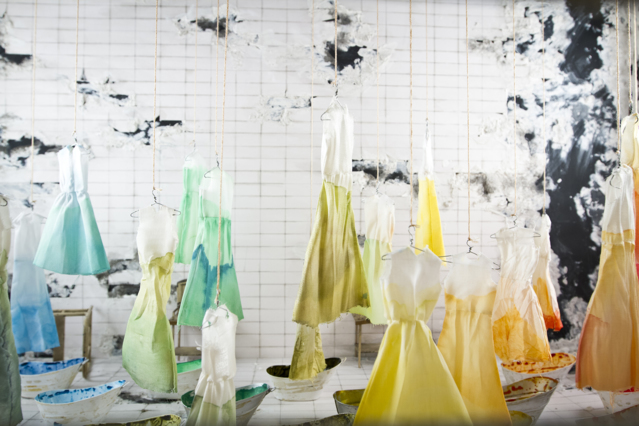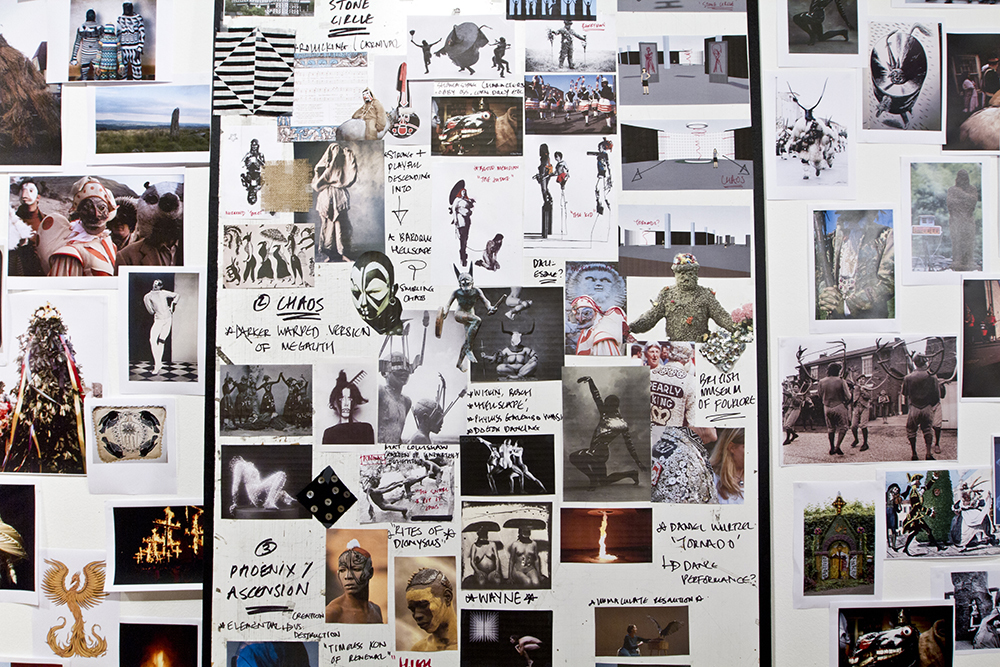Yet with Simon, it’s not merely set design – it’s a fearless and vivid take on an idea that makes a collection. He collaborated with Alexander McQueen from the 90s until his untimely death, and recently has worked with Gareth Pugh on challenging the idea of the catwalk itself, as well as creating sets for photographers like Tim Walker, Paolo Roversi and more. With his friendly and affable nature, Costin sits down with i-D and invites us into his world.
How do you fuse the fantastical ideas in your head with the technical formats that you have to exist in?
Well, I studied theatre design, so the technical was always woven into the design work, the two things sort of go hand in hand really. The technical can inform the design as well as it being the other way around, it depends what the project is because they’re all very different! Every new show that comes along usually needs different forms of fabrication or technical specifications, whether that’s projection or digital mapping.
So have the advances in technology impacted on your designs?
A lot of people almost allow the technology to dictate the idea, where as I would much rather it served it. I still use very old fashioned techniques though… I love scenic painting because it’s actually somebody with a paintbrush, with paint!
What are your main inspirations? Or does it change with projects?
With any fashion designer or catwalk show it’s always the collection, because there’s no point going against what the designers are thinking of. You should always use that as inspiration and then pull threads out. An audience might not necessarily perceive everything when they view the show and that’s how I see my job really, giving layers of meaning that the audience may miss. You need to help the audience understand the collection but not bedazzling them so much that all they can remember is the set.
When you worked with Alexander McQueen was it just a genuine creative understanding of what you both wanted?
Yes, very much.
And do you have that now still with designers?
Yes, with Gareth Pugh, for example, and I work a lot with Hermes,and they’re a long standing client so we have this sort of sympathetic relationship that’s developed over years.

Your work for designers such as McQueen and Gareth Pugh… they’re very strong, even dark ideas.
I am quite dark, I don’t mind admitting that, which is why I think I worked with Alexander McQueen so well. But recently I’d say, a lot of the work has become much more heady, not as visually shocking or outrageous, it’s much more thoughtful and melancholy actually.
So what would you say is the state of the fashion show now?
It’s weird because at one end you have people like Chanel doing the biggest spectacles and then you’ve got people who aren’t actually doing anything at all because they don’t have any money. When Gareth started, we had no money at all – and we still haven’t got much – but he allowed me to try out ideas like the inflatable catwalk. It’s just a long piece of silk with a fan at the end and the models just had to ponystep to avoid getting tripped over. You don’t have to spend a lot of money just to give a nice visual impact to a presentation. Not enough people take the risk. I think everything’s become very safe recently, probably because of the economical situation, but that’s when you should be reacting surely?
So are you open to working with new designers if they are willing to take risks?
I love working with new designers! To be honest fashion shows aren’t a means of making money as a set designer, they’re to do with ideas and to do with you being able to express something that you never get a chance to do.
Your understanding of garments is so strong, do you think that’s important?
I love hanging out in Gareth’s workshop when he’s actually cutting and watching what the assistants and the machinists are doing, because it’s another form of construction that is equally interesting. It doesn’t necessarily inform what I do, but seeing that process is inspiring.
One last thing… what’s been your favourite work that you’ve created?
That’s really hard! I designed a party for Ferragamo in Florence, in a beautiful palazzo, and it was all based on Cinderella, but the original Cinderella story that’s a lot more horror than fairy tale, where the ugly sisters cut their toes off to fit in the glass slipper. Ferragamo allowed me to play to the true story of Cinderella in this building. We had rooms filled with blood on trays and knives, we forested a whole corridor, and everything in that corridor was edible, there were mushrooms and berries and things you’d find in a wood, tree branches that you could snap pieces off and eat. This was in the days when you could spend an absolute fortune on a party! It took six months to build!
Simon Costin’s Impossible Catwalks runs at The London College of Fashion’s Fashion Space Gallery between 12 September and 13 December 2014
Credits
Text Bojana Kozarevic
Photography Katy Davies
